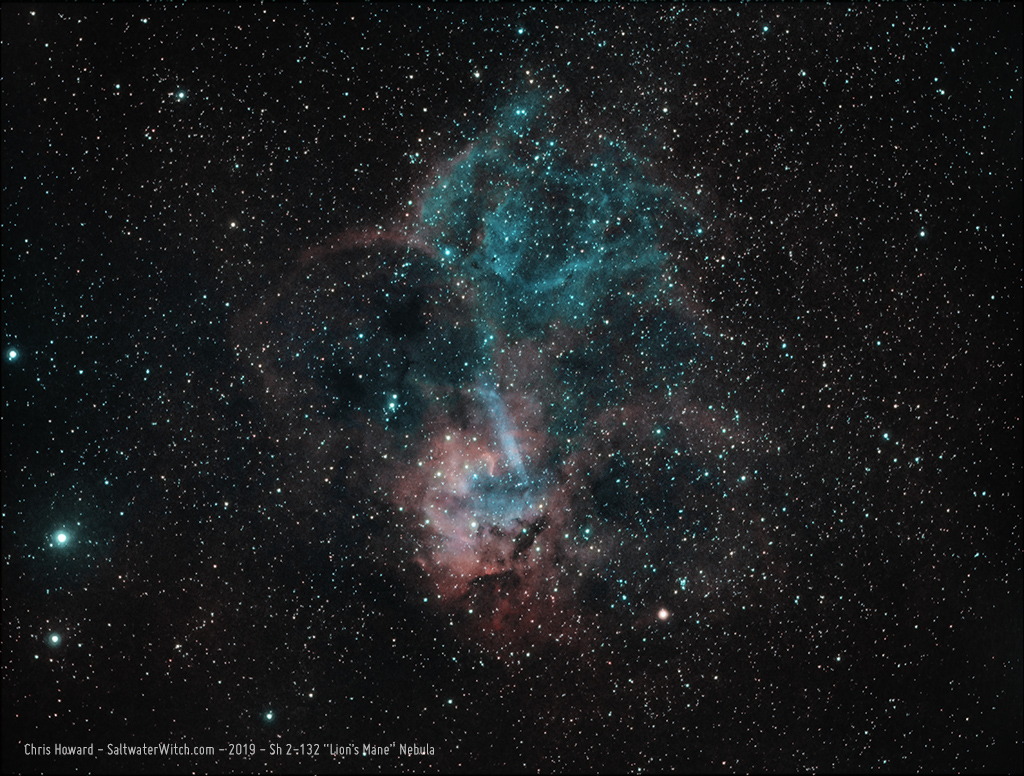Second night out with the Apertura 8" Newt
I selected IC 5146, the Cocoon Nebula as a nice broadband color target for my second clear night with the Newt, and at 800mm focal length, the Cocoon should fit nicely in the frame, with room for the long trail of dust flowing away from it--if I can manage it.
Mechanics: the stars only look slightly better tonight, still wacky around the edges. They were a coma-induced mess last night, but I rearranged some of the imaging train and...it looks, well, not much better. But I'll get there. I am not the type to spend all night twiddling with spacers and digital calipers to calculate the correct back-distance and eliminate every last trace of coma. I'd rather image, and make small corrections along the way, even if it means the stars look like crap before I get things properly dialed in.
So, I was also looking for a nice target to shoot while the Cocoon climbed a bit higher in the sky, more than 30°, and I went for NGC 6946, Caldwell 12, the Fireworks Galaxy in Cepheus. I don't normally go for galaxies, unless they're relatively close by, but there are a few like M101 (Pinwheel Galaxy) and M81 (Bode's Galaxy) which are great targets if you're running with less than a 1000mm--other than the obvious ones like M31, M33, LMC, etc.
The Fireworks Galaxy is 22 million lightyears away. To put that distance in perspective, one lightyear is almost 6 trillion miles. I'll leave the multiplying by 22 million up to you. Fireworks is a medium-sized galaxy, about half the size of the Milky Way at about 40,000 lightyears across. It's a spiral galaxy, and it has the advantage, from our perspective, of being face-on, or is that top-down? Notes: 31 x 120 second subs, no filters.
NGC 6946, Caldwell 12, the Fireworks Galaxy in Cepheus:
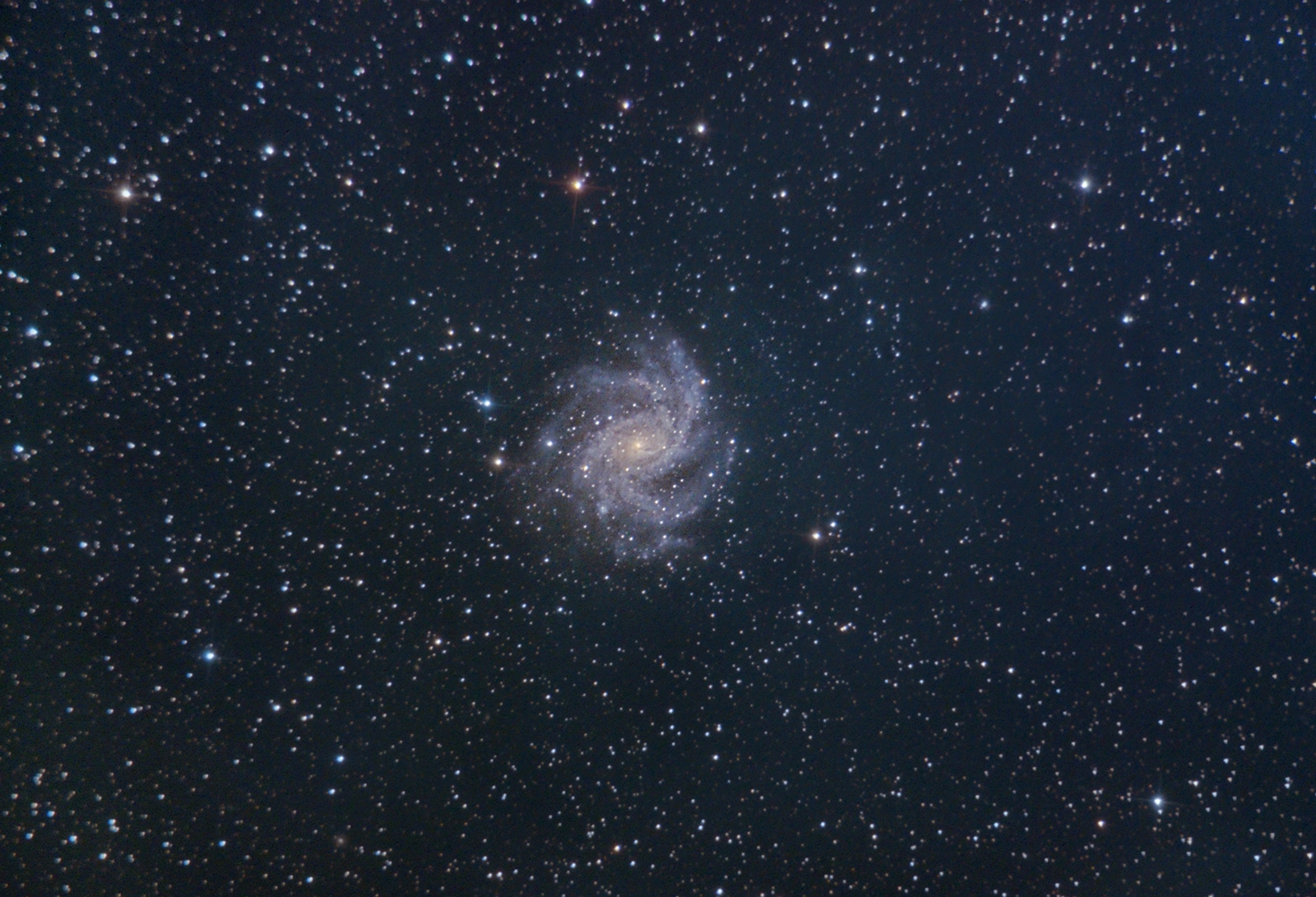
The Cocoon Nebula (IC 5146, Caldwell 19, Sh 2-125) is a roiling mix of new stars, ionized gases emitting light, mostly in wavelengths out at the hydrogen end of the spectrum, with additional layers of clouds of dust and gas lit up by those same stars. Actually, most of the ionizing weight appears to be carried by the central pre-main-sequence B type star, BD+46°3474. The whole circular structure labeled IC 5146 is a reflection nebula and an H ii region that forms a "cocoon" around BD+46°3474 (that bright star in the center), which is probably less than a 1 million years old and is probably closer to 100,000 years old (compare that to our star, the Sun, at 4.6 billion years old). This central star's intense radiation and stellar winds have hollowed out the dense molecular clouds, and the radiation flowing off it is ionizing the material and lighting it up. There's a long dark band of gas trailing off frame at the bottom of this image that leads to a separately identified dark nebula, Barnard 168 (B168). The Cocoon is around 2500 lightyears away in the constellation Cygnus. Imaging Notes: There's so much going on here across the visual spectrum right on out to hydrogen-alpha and near-infrared. Most color astro cameras, DSLRs, and mirrorless cameras will be able to pick it all up. If you can, light pollution allowing, try to catch the Cocoon Nebula without any extra filters. My imaging run: 67 x 240 second subs, no filters. Apertura 8 inch f/4 800m FL Imaging Newtonian, ZWO ASI071MC color camera, GSO Coma Corrector, SkyWatcher EQ6-R Pro mount, Stellarmate/Raspberry Pi 4 running INDI/Ekos/KStars.
IC 5146, the Cocoon Nebula in Cygnus:
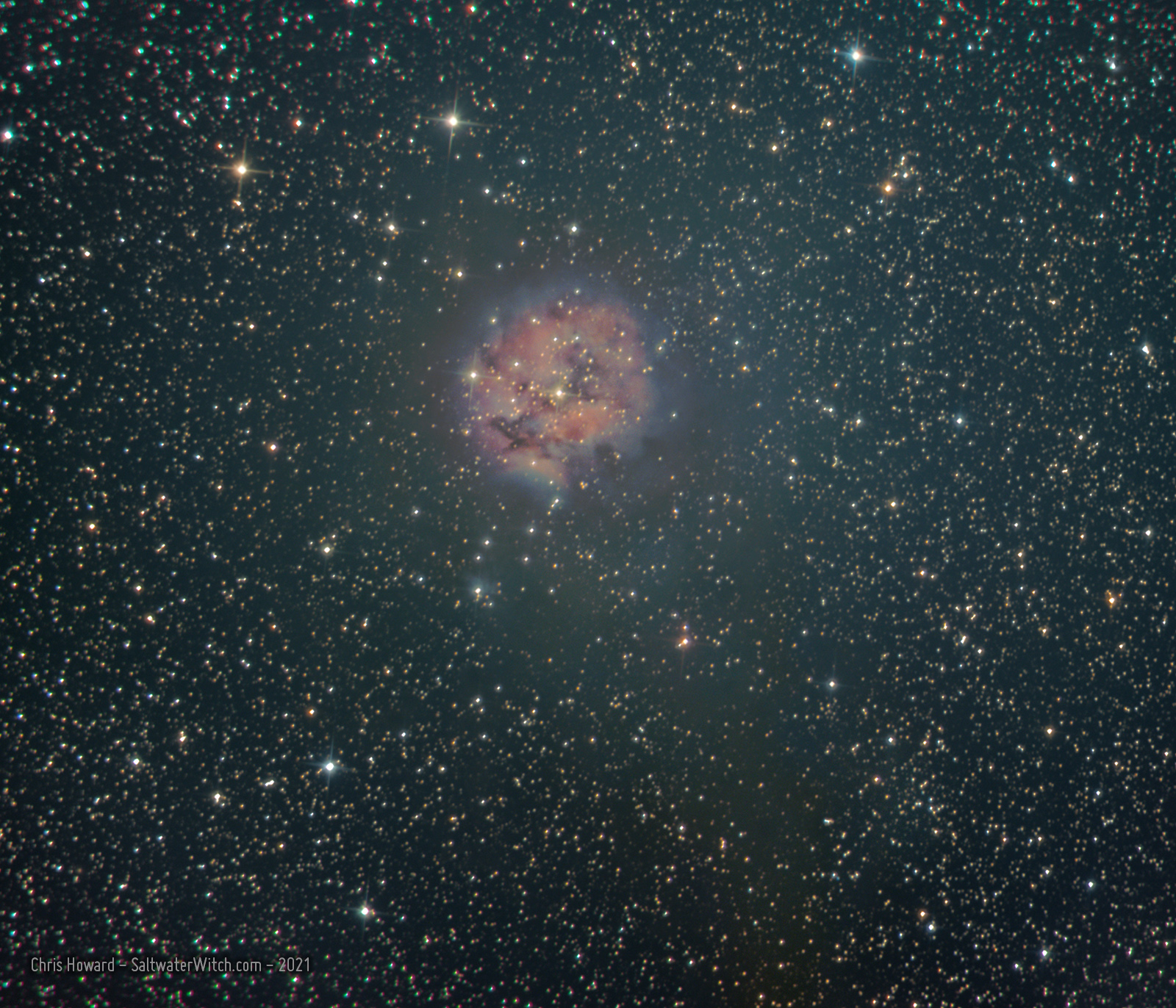
Posted June 18, 2021
NGC 6820
NGC 6820 (Sh2-86) in hydrogen-alpha narrowband. This emission nebula in the constellation Vulpecula is made up of one vast pillar and several not-so-vast pillars of dark molecular dust and gases that have been eroded by the driving stellar winds and intense radiation of the star cluster NGC 6823 (above NGC 6820 in this rotation). Did someone say, "Bok globules"? Yeah, we got those, small dense chunks of dust and gas (hydrogen, carbon, helium, silicates, etc.) that lead to star formation. Of course, small is relative in this case. You can probably take a dozen copies of our entire solar system, including the Kuiper Belt and Oort Cloud and easily fit them all inside most. I gave this monochrome image a hint of vintage tint, a bit or warmth, to counter the core temperatures of Bok globules, which are thought to be some of the coldest objects in the universe. It also makes the image appear a bit brighter.

Posted June 11, 2021
California Nebula in Ha + SII
Tuesday night I captured 50 x 4-minute sub-exposures in Hydrogen-alpha for NGC 1499 (California Nebula) and last night I captured 60 x 240 second exposures in Sulfur 2 (SII), combining them here into a color image, with Ha in red, SII in blue, and each shared equally across the green channel of an RGB image. There just isn't any OIII (Oxygen) in the mix for this massive emission nebula in the Constellation Perseus. Gear notes: SkyWatcher EQ6-R Pro mount, William Optics GT81 Apochromatic Refractor 392mm at f/4.7, ZWO ASI1600MM-Pro monochrome camera, Astronomik 6nm filters, Raspberry Pi 4 4GB / 128GB running INDI/KStars/Ekos

Posted November 15, 2020
The Wizard
The Wizard Nebula in Cepheus surrounds the star cluster, NGC7380, discovered by Caroline Herschel in 1787. The Wizard is between 7000 and 8000 lightyears away from us, and the core star forming region is about 100 lightyears across. Notes: Shot from my backyard with a William Optics GT81, iOptron CEM25P EQ mount, Moonlite Focuser, ZWO ASI1600MM-Pro Monochrome Camera, Astronomik 6nm narrowband filters.

Posted April 25, 2020
The Wizard and the Soul
I captured almost 5.5 hours of OIII and SII data on NGC 7380 (Sh2-142) the Wizard Nebula and star cluster in Cepheus, along with a full set of narrowband frames for IC 1848 the Soul Nebula in Cassiopeia. I timed things well enough that I captured 20 subs each of Ha, OIII, and SII for the Soul before the earth rotated into early morning. Not a ton of data, but enough to process and see how it looks--not bad, in my opinion. My camera rotation is almost 90º off, almost vertical against the long side of the sensor, but I cropped the nebula to a square so you don't have to see how silly that looks.
I captured the Ha data for the Wizard Nebula early in July, and now I have enough to process in SHO (Hubble Palette) that's where we map the three bandpasses, sulfur (SII), hydrogen (Ha), and oxygen (OIII) to RGB, Red, Green, Blue to make up a color image.
Here's NGC 7380, Sharpless 2-142, Wizard Nebula:
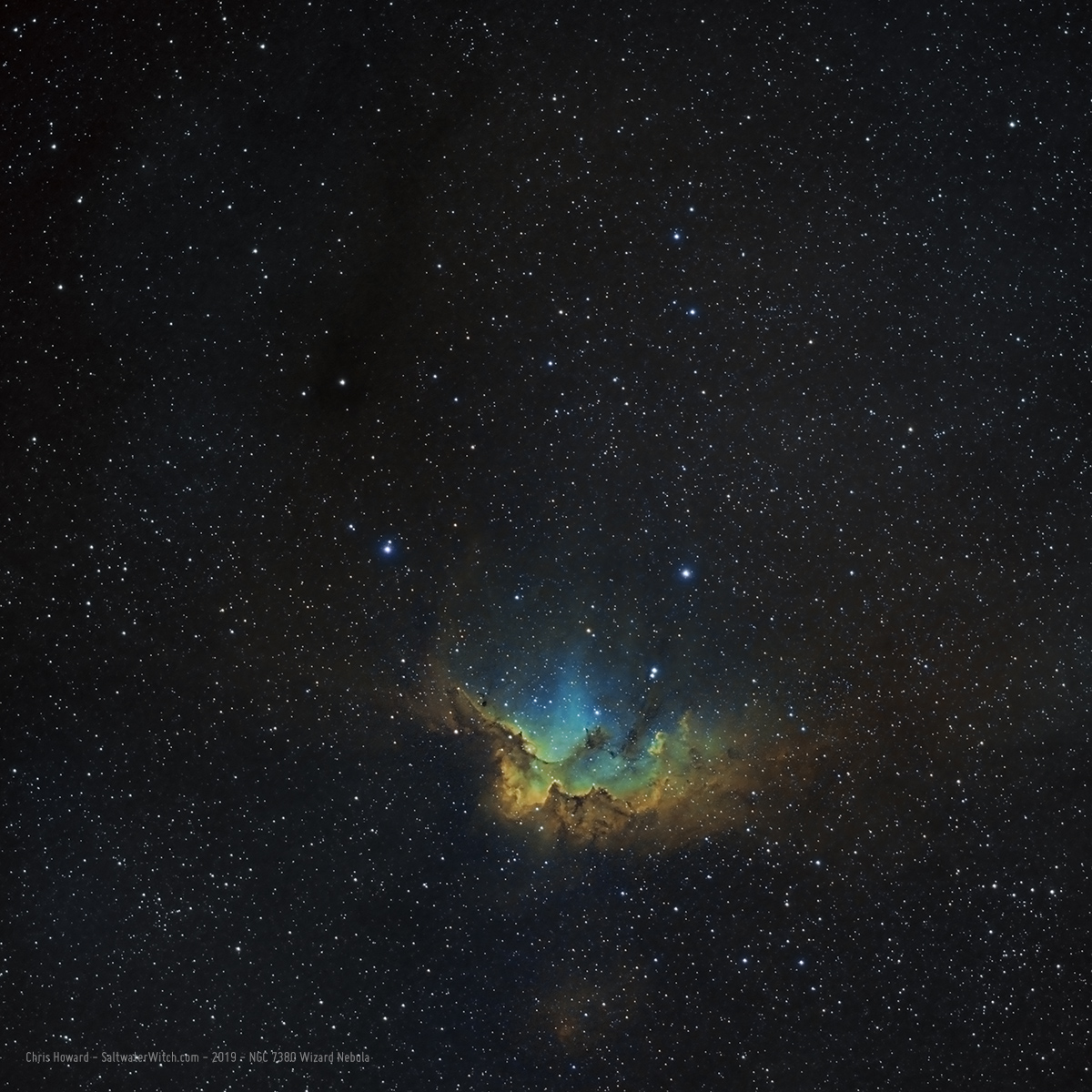
IC 1848, the Soul Nebula:
I don't know if I succeeded but I was trying to get more hydrogen green back into the arrangement. Most of the nebula is hydrogen--just going off the signal in the Ha frames compared with the OIII and SII data. The rims of both regions of IC 1848 are thick with sulfur--red and green gets us that golden brown, but I think the processes, filters, actions typical for astro imaging go too far in reducing green in the images, bending it more toward blue. This does have the benefit of bringing out oxygen, which is nowhere near as plentiful as the blues I see in most SHO/Hubble Palette images. That's just what everyone's come to expect from a "Hubble" image. On the other hand this is one of the coolest aspects of the hobby, the ability to go back and re-processes your data, because you have new or improved processing tools or skills, a new set of data, or simply because you want to experiment with color allocation.
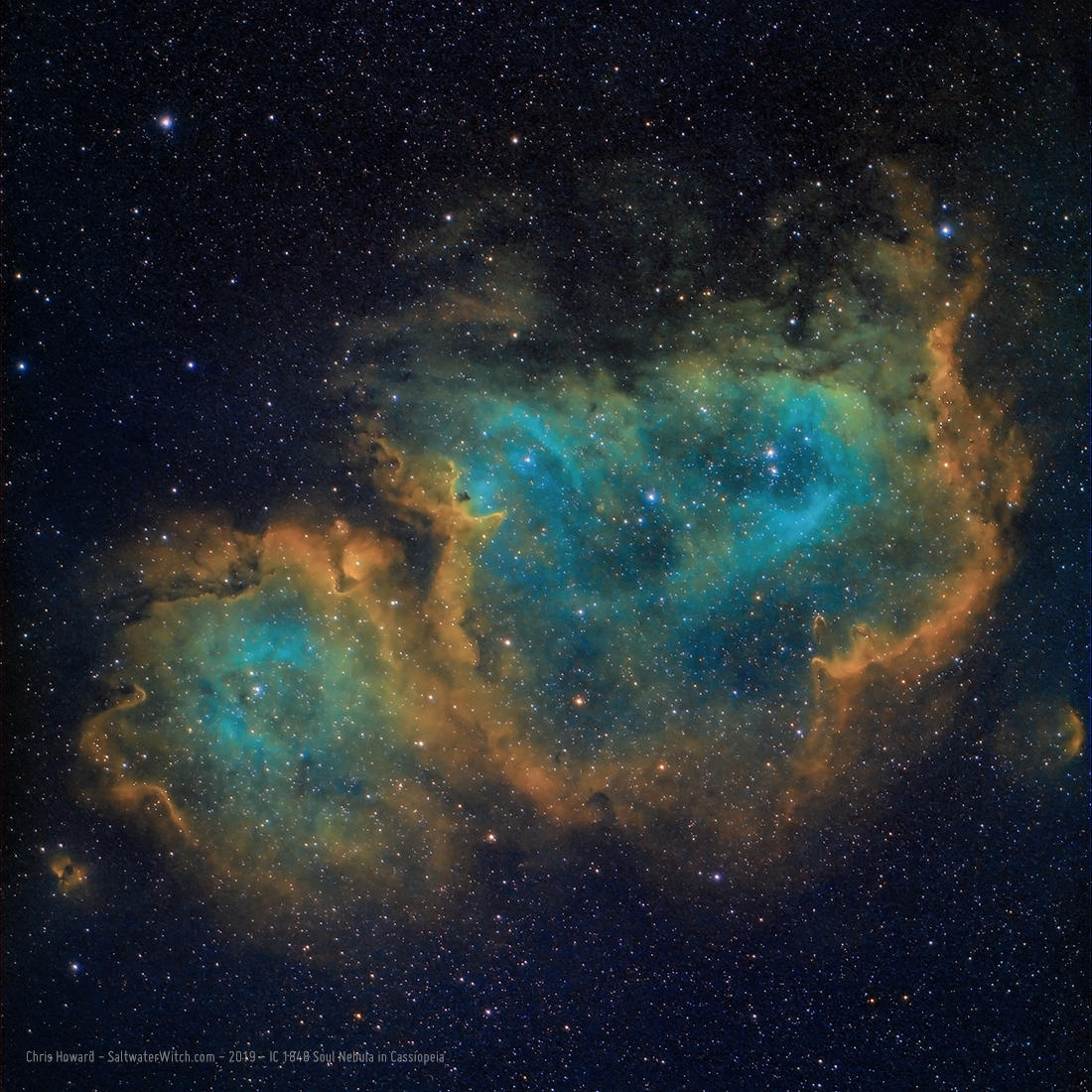
I woke up around 3:30 am and went out to check on the night's imaging run. I was in the middle of the sulfur2 frames when I took this shot with the Nikon: the William Optics GT81 APO refractor pointed at Cassiopeia (top left), actually just below it, which is where you will find IC 1848, the Soul Nebula. Just so you are aware, this is all automated--slewing, plate solving, focusing, filter rotation, and image capture. Once I plot and schedule an imaging run, the last place I want to be is near the telescope where the slightest motion in the ground can ruin a good 5-minute exposure. I was just out there to look at the beautiful sky, and take some crappy blurry photos of my astro gear against the starry background.
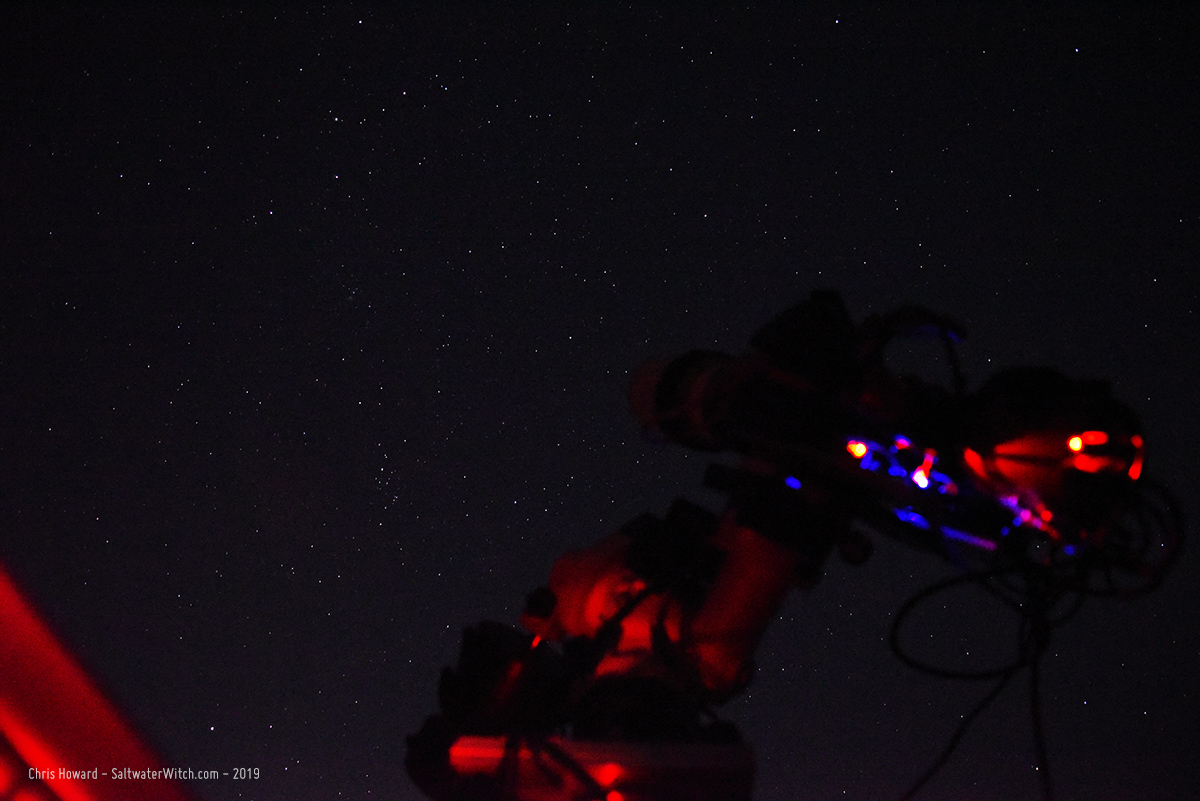
Posted August 2, 2019
Pelican Nebula ( IC 5070 and IC 5067)
Another one from my June 8th narrowband imaging run through the constellation Cygnus. The Pelican Nebula ( IC 5070 and IC 5067) in sulfur 2, hydrogen-alpha, oxygen 3, mapped to RGB.

My narrowband imaging rig: William Optics GT81 (81mm aperture, focal length 392mm, f/4.7), Moonlite Focuser, Pegasus Astro Power, and ZWO monochrome cameras and EFW.
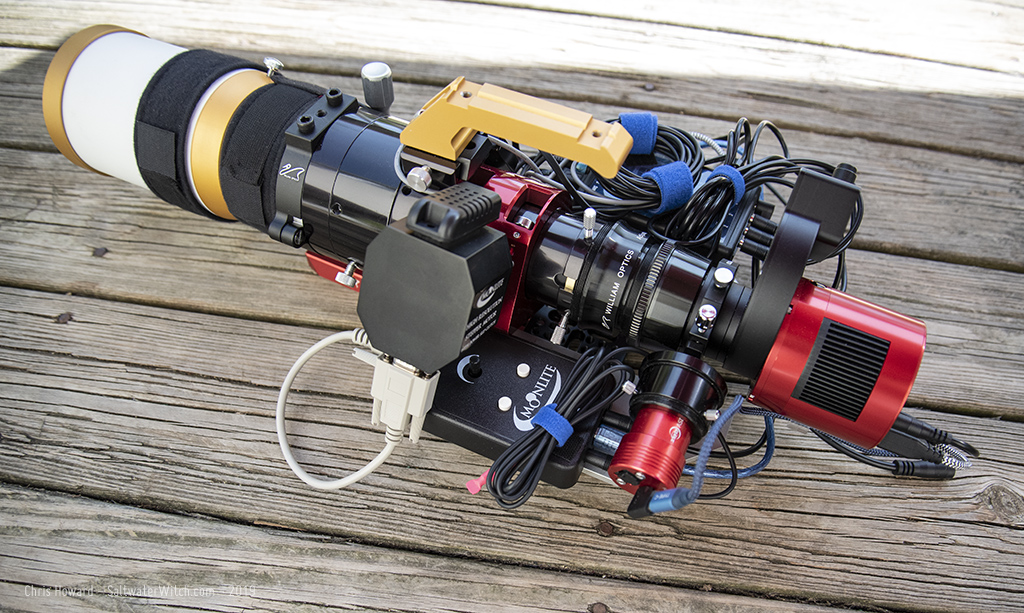
Posted July 25, 2019
Short nights, narrow bands, works in progress
We probably have less than four hours of seriously dark night this time of year--at my location, coastal New Hampshire. And you have to make do with that. So, last night I spent every minute on hydrogen-alpha frames for three targets, Sh 2-54 (with the star cluster NGC 6604 in the center), NGC 7830 Wizard Nebula, and NGC 281 Pacman Nebula. I went through each of these and shot 30 x 180 second exposures, starting around 10:30 pm, which is still a bit within astronomical twilight.
The nebula Sh2-54 is about 5000 lightyears away in the constellation Serpens. It's part of a long band of nebulosity that extends almost ten degrees through the Eagle Nebula (M16) and Swan/Omega Nebula (M17) below that. NGC 6604 is the cluster of stars above and to the right of the brightest knot of the nebula. Imaging notes: 30 x 180 sec Ha sub stacked in DSS and processed in Photoshop CC.
NGC 7830 is the star cluster surrounded by the Wizard Nebula, an HII region about 7200 lightyears away in the constellation Cepheus. This is 30 stacked 3 minute exposures, no calibration frames.
NGC 281, called the Pacman Nebula for obvious reasons is an HII region in Cassiopeia. Pacman has some amazing features including a batch of really distinct Bok Globules, those small dark nebulae full of cosmic dust that may be playpens for newborn stars. William Optics GT81, ZWO ASI1600MM-Pro, Astronomik Ha 6nm filter, 30 stacked 3 minute exposures, no calibration frames.
NGC 281 Pacman nebula in Ha:
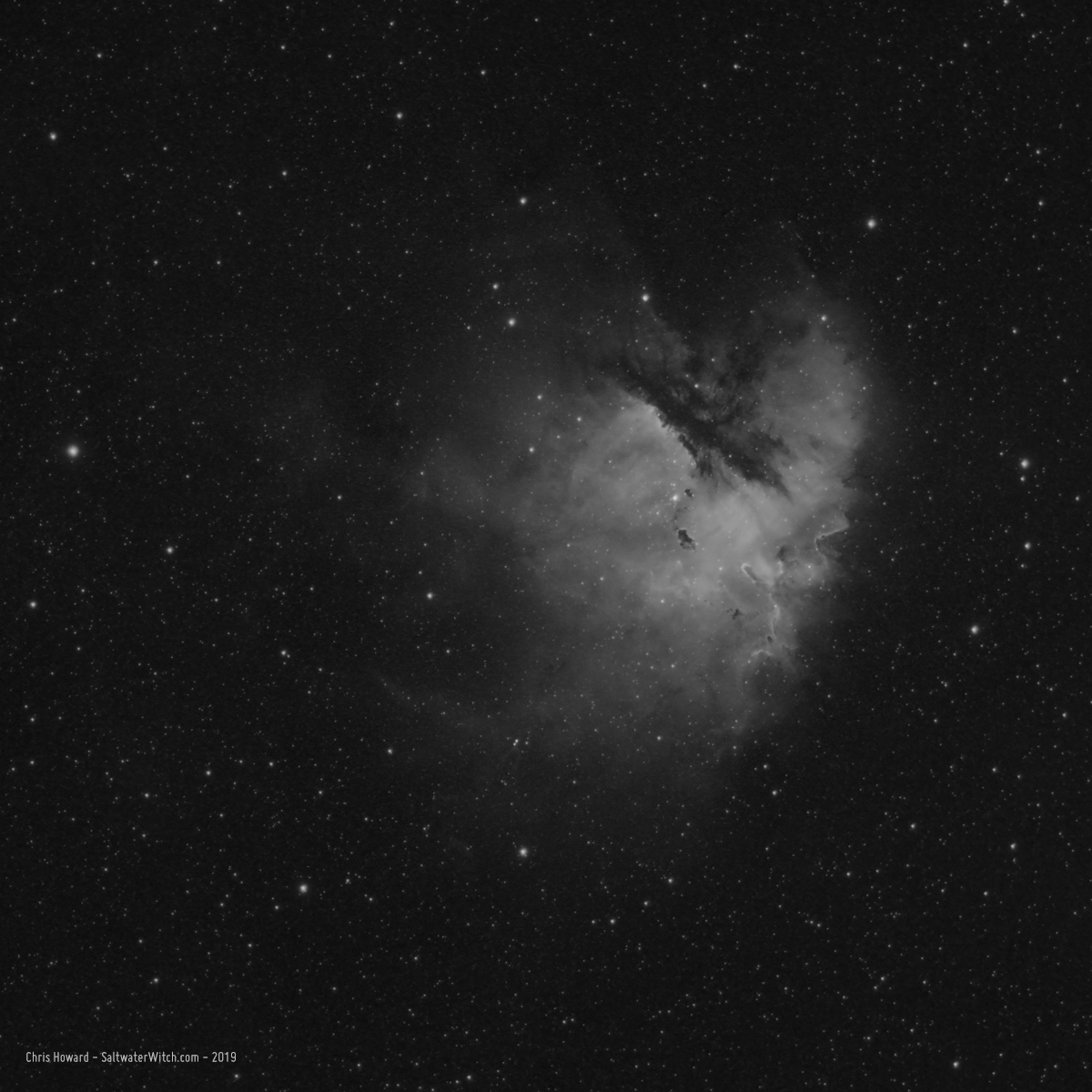
NGC 7380 star cluster surrounded by the "Wizard Nebula" in Ha:
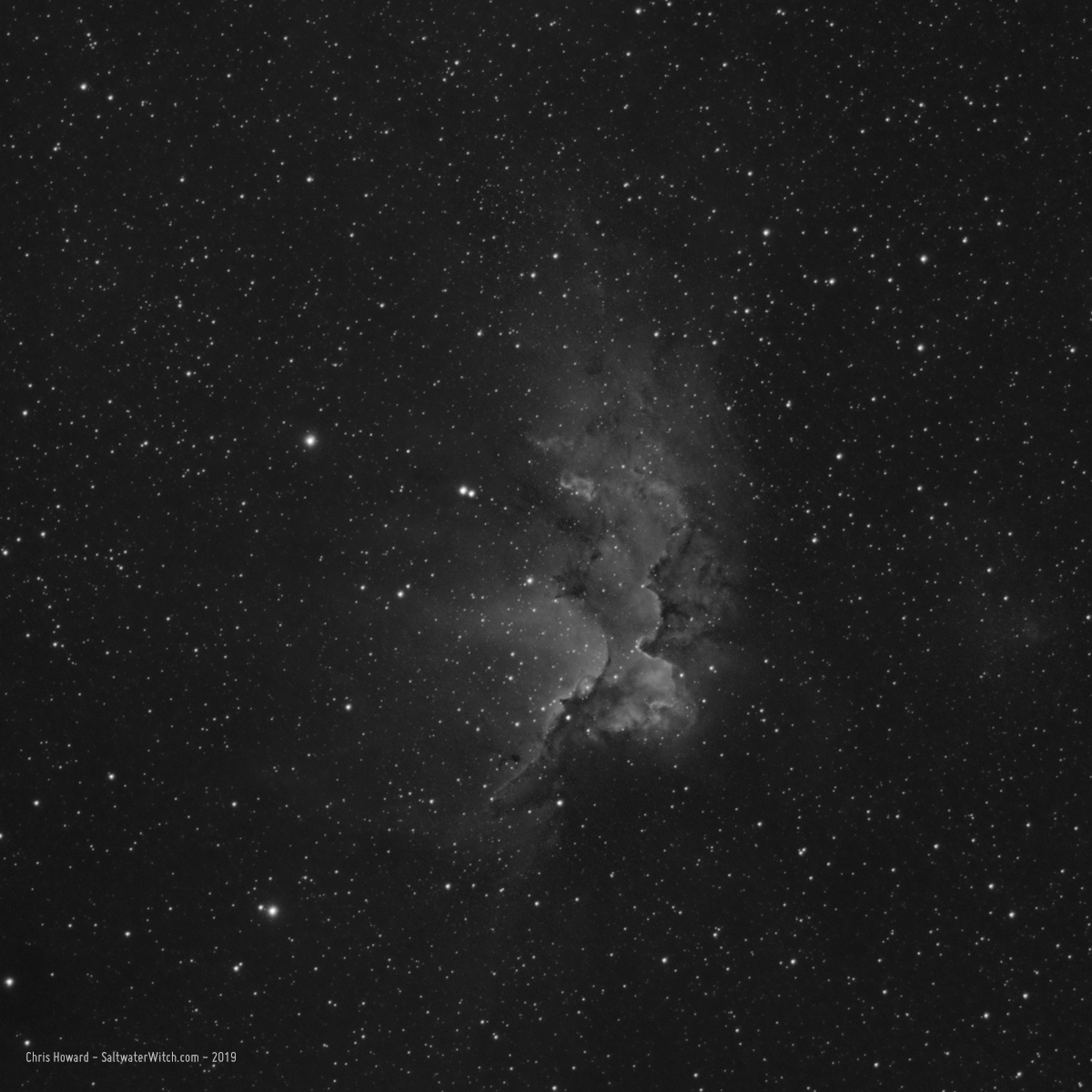
Sh2-54 Nebula and NGC 6604 open star cluster in Ha:
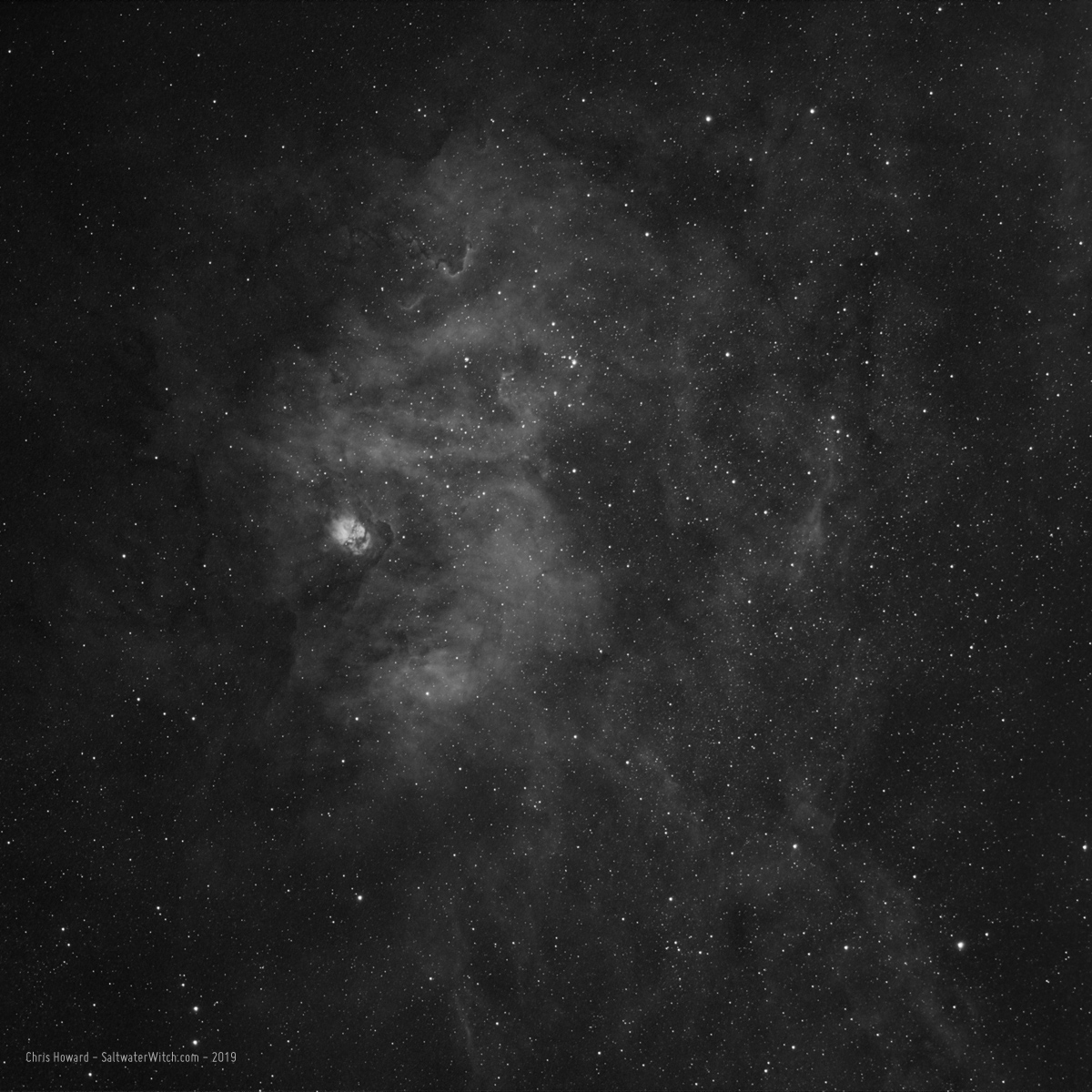
Posted July 9, 2019
Lion's Mane in Cepheus
Work-in-progress for Sh 2-132 "Lion's Mane" emission nebula on the border between Cepheus and Lacerta, about 10,000 lightyears away, and over 300 lightyears in diameter. This is why Cepheus is such a wonderful constellation. The Lion's Mane is another giant HII region with ionization partially provided by two Wolf-Rayet stars, WR 152 and WR 153, which have blown out the rings you see in the image. I'm in the middle of capturing data for this. This is a fairly dim object--I only have about half the frames I want for Ha and OIII, and I haven't even started SII capture yet. Here's a bi-color Ha+OIII for the subs I've captured so far. William Optics GT81 APO refractor, ZWO ASI1600MM-Pro mono camera, Astronomik filters, iOptron CEM25P mount.
